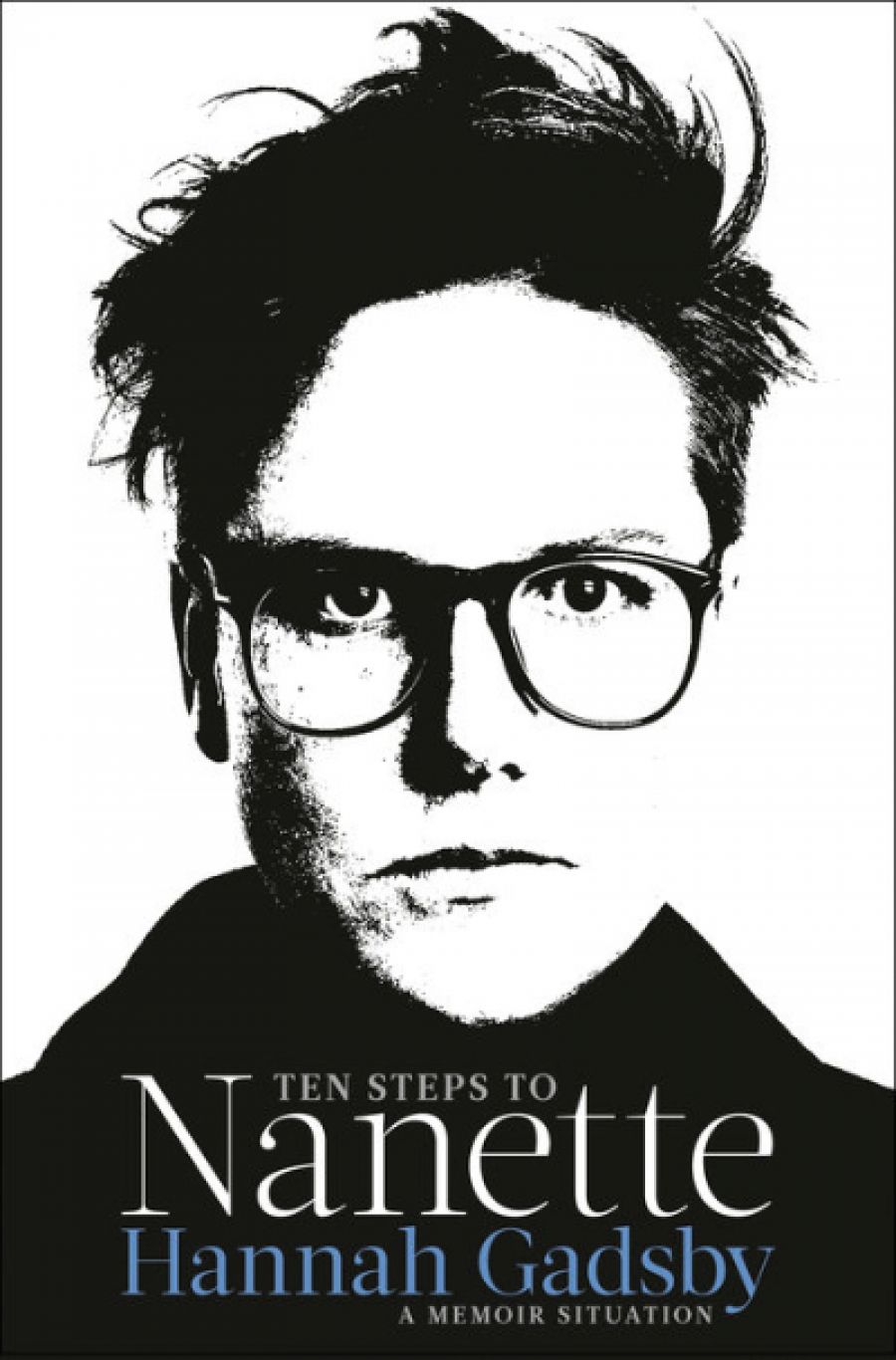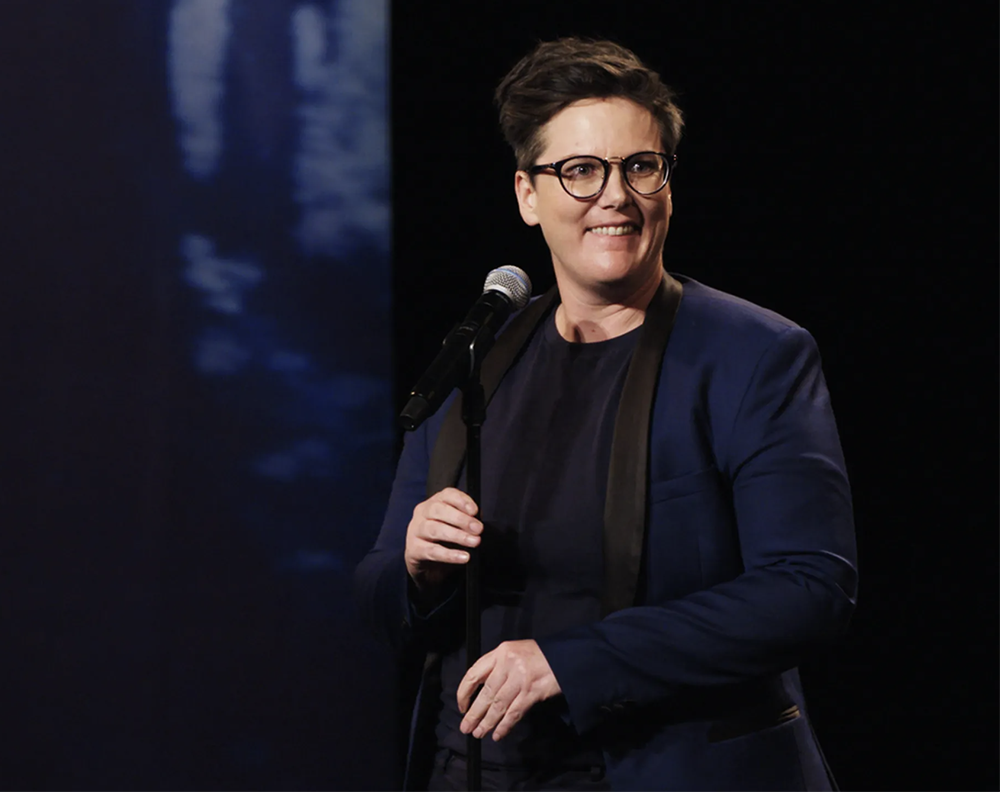
- Free Article: No
- Contents Category: Memoir
- Review Article: Yes
- Article Title: The Nanette turn
- Article Subtitle: A stand-up comic defies convention
- Online Only: No
- Custom Highlight Text:
Hannah Gadsby’s show Nanette (2017–18) starts out funny but then shifts to long, angry monologues that refuse its audience the release of laughter. By breaking the conventional contract between a comedian and her audience, Gadsby rejected her own former practice of turning her traumatic experiences into jokes. Nanette’s international run and subsequent release as a Netflix special spanned the Australian Marriage Law Postal Survey, which gauged public support for marriage equality, as well as the international #MeToo movement against sexual assault.
- Article Hero Image (920px wide):

- Article Hero Image Caption: Australian comedian Hannah Gadsby (photograph via Netflix)
- Alt Tag (Article Hero Image): Australian comedian Hannah Gadsby (photograph via Netflix)
- Featured Image (400px * 250px):

- Alt Tag (Featured Image): Sarah Balkin reviews 'Ten Steps to Nanette' by Hannah Gadsby
- Book 1 Title: Ten Steps to Nanette
- Book 1 Biblio: Allen & Unwin, $49.99 hb, 386 pp
- Book 1 Readings Link: booktopia.kh4ffx.net/qn6QkN
Gadsby’s memoir, Ten Steps to Nanette, details her life leading up to the show that launched her international celebrity and changed stand-up comedy. As Gadsby points out in the book, Nanette came before #MeToo; its early performances responded instead to Australia’s plebiscite on marriage equality in 2017, which revived traumatic memories of public debates about homosexuality during Gadsby’s childhood. (In 1997, Tasmania became the last Australian state to decriminalise homosexuality.) Threaded through the book are a history of gay law reform in Australia and explanations of how the homophobia and gender norms Gadsby encountered as a young person in Smithton harmed her. By positioning herself as a person from a particular time and place, Gadsby qualifies her post-Nanette international celebrity as an icon of the woke left.
Gadsby asserts her cultural specificity in a different way when, early in the book, she takes ‘a moment to directly address any Americans who may be reading this: your comedy gods are not mine’. She emphasises that she is a festival comic, meaning that rather than ‘stacking jokes one on top of the other’, as American stand-ups conventionally do, she makes ‘shows out of interconnecting material that is designed to pull an audience through a cohesive hour-long experience’. By reminding American readers that Nanette has generic antecedents in festival comedy, Gadsby also reminds them that she is skilful and had a career in Australia prior to the show.
With its interconnecting subsections on Gadsby’s life and career, Australian gay law reform, and her experience of autism, Ten Steps to Nanette might be described as a longer-form version of her approach to festival shows. But where in Nanette Gadsby was ‘at war with the form’ of comedy, in Ten Steps she gently bends the form of memoir. Gadsby calls attention to her interventions into genre conventions when, for example, she distinguishes her approach from that of an ‘imaginary ghostwriter’ who ‘would insist on putting at the top’ of her account of her life at the age of twelve the fact that she was being ‘intermittently molested’ by a man in her community. Gadsby chooses not to lead with this experience, she explains, because ‘when you are forced to keep a trauma secret in order to survive, you need to actively avoid incorporating the traumatic event into your official version of self’. Gadsby wants her perspective of that time to structure the story, but also explains how events affected her even when she was unaware of or emotionally distancing herself from them.
The book also revises the chronology conventional to memoir; for example, Step 1 is an epilogue, while a prologue follows Step 10. Gadsby’s concluding prologue is a previously unpublished story she wrote as a child, which she describes as technically her first book: ‘How Siffin Soffon Became Friendly with a Dragon’. There is a long tradition of queer interventions into chronology; for instance, Gertrude Stein’s opera Four Saints in Three Acts (1928) features neither four saints nor three acts and includes an instruction to repeat the first act. But Gadsby links her own reordering to trauma more than to queerness, noting that ‘there is never a straight line to be found through a life punctuated by trauma’. Here, as in her performance work after Nanette, she experiments with genre conventions, which are socially recognised ways of organising and understanding stories.
Fans and scholars of Gadsby’s work may find the book most enlightening in its restoration of her autistic perspective to her writing and performance of Nanette. Gadsby intentionally excluded her autism from the show because she realised that the ‘misinformation that is built into most people’s understanding of it’ would get in the way of what she wanted to say. While Gadsby has discussed her autism in subsequent shows such as Douglas (2019), Ten Steps reveals the safeguards she put in place to protect herself and her audiences from meltdowns triggered by reliving her traumas while performing Nanette.
Noting that sounds can cause her physical pain and, less often, pleasant feelings, Gadsby describes how she seeded the show with ten phrases that made her feel good, such as the line about her favourite ‘sound of a teacup hitting its saucer’. Gadsby spent several days alone repeating these phrases ‘over and over again under the influence of my best guess at microdoses of MDMA’. She explains that the phrases functioned as disguised modes of stimming – repetitive movements or tics such as hand flapping or rocking back and forth commonly used for self-soothing – during performances of Nanette. Gadsby was thus able to regulate her emotions and retain her authority on stage. This account of Gadsby’s neurodiverse performance practice shows how a sophisticated program of masking (performing social behaviours considered neurotypical) facilitated the delivery and reception of a show whose premise was that comedy could not tell Gadsby’s full story.
Nanette’s impact on contemporary comedy is still being felt. At the 2021 Melbourne International Comedy Festival, trans comedian Anna Piper Scott called a section of her show that contained traumatic material the ‘Nanette turn’, suggesting that Gadsby’s genre intervention has become a convention in its own right. Ten Steps to Nanette will be felt in a different way, not as a revolution in the genre, but as a fuller account of the life of an artist who has been profoundly affected, and who has affected others, by telling her own story.


Comments powered by CComment